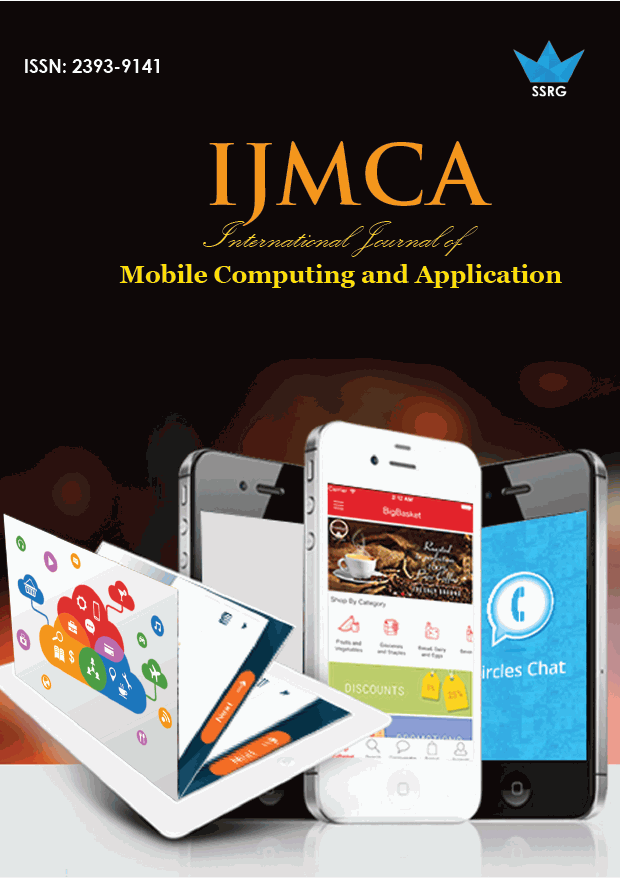Assimilating Smart Devices In The Practice of Teaching And Learning To Bring An Effective Learning Environment

| International Journal of Mobile Computing and Application |
| © 2021 by SSRG - IJMCA Journal |
| Volume 8 Issue 1 |
| Year of Publication : 2021 |
| Authors : Vencelin Gino V, Senthil Jayapal, Dr.Ramesh Palanisamy |
How to Cite?
Vencelin Gino V, Senthil Jayapal, Dr.Ramesh Palanisamy, "Assimilating Smart Devices In The Practice of Teaching And Learning To Bring An Effective Learning Environment," SSRG International Journal of Mobile Computing and Application, vol. 8, no. 1, pp. 7-10, 2021. Crossref, https://doi.org/10.14445/23939141/IJMCA-V8I1P102
Abstract:
There is an unprecedented development of technology in manifold ways. The number of innovations almost double every two years. Still, most of the classrooms around the world are left with the rudimentary educational environment, "the traditional learning style"; when I say 'traditional,' it only refers to the board and pen. I do not deny the fact that smart boards are already available in the market. But my fundamental question is: "Have the smart boards and other gadgets changed the teaching style in any way?
Keywords:
Smart devices, Effective Learning, smartphones
References:
[1] Seifert, T., Pedagogical Applications of Smartphone Integration in Teaching. International Journal of Mobile and Blended Learning, 7(2)(2015) 1–16. https://doi.org/10.4018/ijmbl.2015040101
[2] Gómez-García, M., Soto-Varela, R., Morón-Marchena, J. A., & del Pino-Espejo, M. J. Using Mobile Devices for Educational Purposes in Compulsory Secondary Education to Improve Student's Learning Achievements. Sustainability, 12(9)(2020) 3724. https://doi.org/10.3390/su12093724
[3] Vakali, E., & Brailas, A.,Me and my students' smartphones in the classroom,: A case study using arts-based methods. Homo Virtualis, 1(1)35. https://doi.org/10.12681/homvir.19070.
[4] Sung, Y.-T., Chang, K.-E., & Liu, T.-C., The effects of integrating mobile devices with teaching and learning on students' learning performance: A meta-analysis and research synthesis. Computers & Education, 94(2016) 252–275.
https://doi.org/10.1016/j.compedu.2015.11.008
[5] 김혜숙., Effects of using mobile devices in blended learning for English reading comprehension. Multimedia-Assisted Language Learning, 17(2)(2014) 64–85. https://doi.org/10.15702/mall.2014.17.2.64
[6] Cook, J., Mobile Phones as Mediating Tools within Augmented Contexts for Development. International Journal of Mobile and Blended Learning, 2(3)(2010) 1–12. https://doi.org/10.4018/jmbl.2010070101.
[7] Hussein Al-Yaseen, Mou'ath Hourani, Saheer AlJaghoub, Success and Failure of e-Learning Projects: Alignment of Vision and Reality, Change and Culture, Journal of Emerging Trends in Computing and Information Sciences, 3(2)(2012).
[8] Shaikh Viquar Ahmed and Chaudhari A.L, Development of Microcontroller Based Tool for Effective Learning of Concepts in Control System, SSRG International Journal of Electronics and Communication Engineering 2(9) (2015) 5-8.
[9] Jasmina Kljunić, Dijana Plantak Vukovac., A Survey on Usage of Mobile Devices for Learning among Tertiary Students in Croatia, Faculty of Organization and Informatics, September 23-25 (2015) .
[10] Bruno Gomes, Rui Gomes, Facilitating Tool for e-Learning in Higher Education Institutions, International Journal of e-Education, e-Business, eManagement and e-Learning, 3(2)(2013).
[11] Dvorak, K., Bleakney, J., Rosinski, P., & Carpenter, R., Effectively Integrating Course‐Embedded Consultants Using the Students as Partners Model. The National Teaching & Learning Forum, 29(1)(2019) 7–9. https://doi.org/10.1002/ntlf.30222.

 10.14445/23939141/IJMCA-V8I1P102
10.14445/23939141/IJMCA-V8I1P102